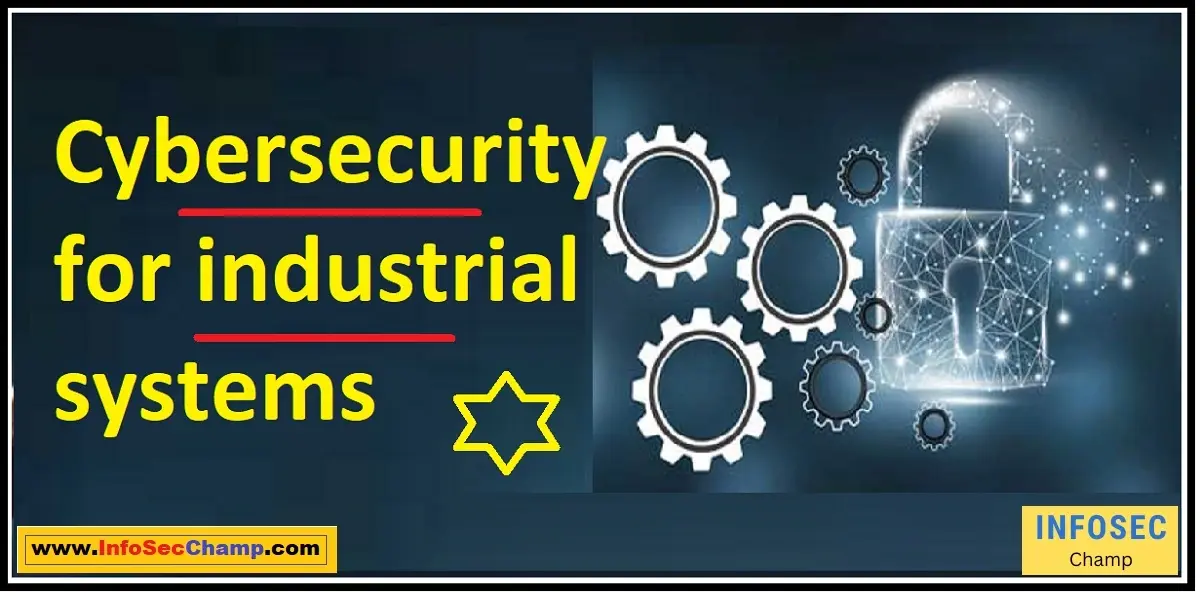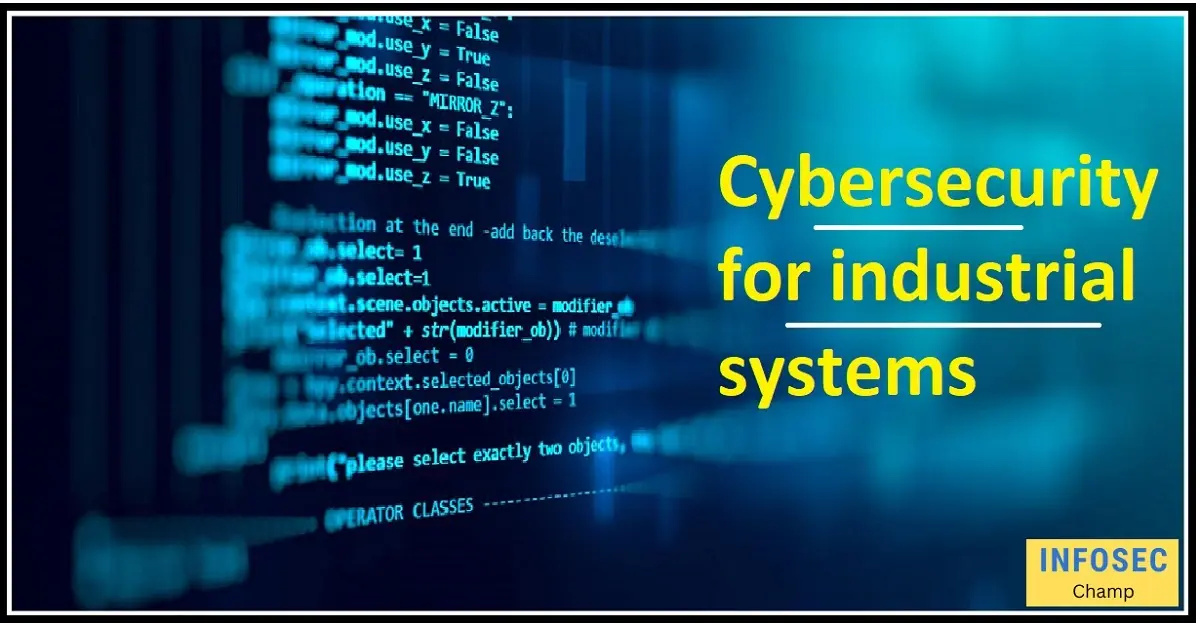Because of the increasing sophistication of hackers, cybersecurity for industrial systems is essential for companies operating in the industrial sector. This is because the risk of a cyber assault on SCADA security, network security, or IoT devices is always rising. Maintaining the efficiency and security of your systems is now more crucial than ever. Top ways to protect your company from cybercrime are provided in this thorough guide to cybersecurity for industrial systems.
To assist you in comprehending and putting into practice reliable security measures, the booklet covers the most recent dangers and state-of-the-art security procedures. You will get useful advice and takeaways that will help you keep on top of cybersecurity developments in the era of Industry 4.0.
What is industrial control system security and why is it important for businesses to implement it?
What is industrial control system security and why is it important for businesses to implement it? Industrial control system security (ICS security) refers to the precautions taken to safeguard the computer systems that regulate an organization’s industrial activities, such as manufacturing, energy generation, and transportation. These systems are susceptible to cyberattacks since they depend on a combination of hardware and software to work, which might jeopardize their performance or possibly result in physical injury.
ICS security measures must be implemented by enterprises for the following reasons:
- Protecting critical infrastructure: The systems controlled by ICS technology are typically important to the operation of critical infrastructure, such as power plants, water treatment facilities, and transportation networks. Any disruption to these systems might have major ramifications for public safety and the economy.
- Preventing data breaches: As part of their routine operations, many industrial control systems gather sensitive data. If this data enters into the wrong hands, it could be exploited for malevolent objectives such as identity theft or business espionage.
- Ensuring business continuity: When industrial control systems are compromised, the impacted organization may experience lengthy downtime. This not only leads in lost production and income but may also affect the company’s reputation.
- Compliance requirements: Many industries are subject to regulatory frameworks that require particular security measures to be in place for industrial control systems. Failure to comply with these rules may result in penalties, legal action, and reputational harm.
- Defense against cyberthreats: Industrial control systems are a popular target for attackers, and cyber threats are continually emerging. Businesses may secure their assets and keep ahead of these risks by implementing ICS security measures.
Overall, industrial control system security is essential for safeguarding vital infrastructure, preventing data breaches, guaranteeing business continuity, fulfilling compliance obligations, and fending off online attacks. Any company that uses industrial control systems should give strong security measures top priority when it comes to protecting their systems and assets.”
How can SCADA systems be protected from hacker attacks and unauthorized access?
SCADA systems, which stand for Supervisory Control and Data Acquisition, are an essential piece of infrastructure for managing and observing industrial processes. These systems are susceptible to cyberattacks that can seriously harm industries since they are frequently connected to the internet.
How therefore can SCADA systems be protected from online threats and unauthorized access?
Here are some actionable steps that can be taken:
- Update and patch software regularly: Regular updates and patches are essential to fix vulnerabilities in the software that can be exploited by hackers.
- Implement access control mechanisms: Access control methods such as password policies, multi-factor authentication, and role-based access control can prevent unwanted access to the SCADA system.
- Isolate SCADA systems from the internet: Blocking internet access for SCADA systems can lessen the likelihood of cyberattacks. Physical access to the system should only be allowed to authorized individuals.
- Perform regular security audits: Routine security audits can assist in identifying vulnerabilities and prompt mitigation.
- Use strong encryption: Encryption can prevent attackers from accessing sensitive data transmitted between devices.
- Train staff: Frequent training can help personnel spot phishing emails, social engineering attacks, and other attacks that might compromise SCADA systems.
- Implement intrusion detection and prevention systems. These systems can identify and stop cyberattacks on the SCADA system.
In sum, securing SCADA systems from cyber-attacks and unauthorized access is a continual activity. To lessen dangers to these vital systems, it is crucial to take a proactive approach. Organizations can considerably lower the risk of cyberattacks on SCADA systems by taking the above actions.”
Who should be responsible for implementing cybersecurity measures for industrial systems?
Industrial systems have been subjected to an increasing number of cyberattacks as the world becomes more and more digitalized. In fact, industrial cyber-attacks have been expanding at an alarming rate, resulting to major consequences such as production delays, loss of data, and even physical damage. The right party must be tasked with implementing cybersecurity measures for industrial systems in order to reduce these risks.
Here are some critical points to consider when considering who should be accountable for adopting cybersecurity safeguards for industrial systems:
- Industry leaders: Industry leaders have a crucial role to play in formulating cybersecurity policies and actions since they have in-depth knowledge of the specific dangers affecting their sector.
- IT departments: IT specialists play a significant role in assuring the security of the systems, networks, and devices linked to industrial systems.
- Operations and engineering teams: These teams are essential to managing systems and assuring their continued safety and functionality. They also play a crucial part in putting cybersecurity safeguards into place that mesh with regular business operations.
- Security professionals: Industrial cybersecurity initiatives require the participation of cybersecurity experts who have a thorough awareness of the most recent threats, vulnerabilities, and best practices.
While each of these stakeholders is crucial to the implementation of cybersecurity measures, it is obvious that cooperation is key. Companies must make sure that all parties involved collaborate to create thorough rules and processes that safeguard industrial systems from new dangers. The organization must ultimately be in charge of putting cybersecurity safeguards in place, and each stakeholder must take responsibility for their part. Organizations can reduce risks and safeguard their systems from new threats by adopting a collaborative and all-encompassing approach to industrial cybersecurity.
When is the right time to implement cybersecurity measures to prevent cyber-attacks on industrial systems?
The type of industrial system and its criticality, the type of cyberattacks, and the resources available for cybersecurity all play a role in determining when it is appropriate to take cybersecurity measures to stop cyberattacks on industrial systems.
These are some things to think about:
- It is essential to put cybersecurity safeguards in place as soon as feasible since cyberattacks on industrial systems are growing more common and sophisticated. Waiting until an assault happens can be expensive, harmful, and time-consuming to recover from.
- Cybersecurity measures should be put in place as soon as feasible, ideally, before the industrial system goes online if it is essential to the infrastructure or public safety, such as a power grid, transportation network, or water treatment facility.
- To make sure that the security measures put in place are efficient and current, it’s also crucial to identify the industrial system’s weaknesses and hazards and routinely evaluate its cybersecurity posture. Doing a cybersecurity audit, vulnerability scanning, penetration testing, and threat intelligence analysis are some examples of how to do this.
- The industrial system should be protected by cybersecurity safeguards from a variety of cyberattacks, including malware, phishing scams, ransomware, insider threats, and denial-of-service attacks. This may entail putting in place firewalls, intrusion detection systems, antivirus programs, encryption, access controls, and incident response procedures.
- The timing of deployment may also be influenced by the cybersecurity resources available. For instance, if a small or medium-sized business owns and runs the industrial system, it might not have as many resources as a major company or governmental organization. In such circumstances, cybersecurity measures can be gradually applied, beginning with the most important assets and expanding until they are fully covered.
In summary, it is best to deploy cybersecurity measures as soon as possible, ideally before the system goes online, to stop cyberattacks on industrial systems. It entails locating weaknesses, evaluating risks, and putting in place a variety of safeguards to defend the system from various cyber-attacks. The system’s level of importance, the resources at hand, and the degree of risk can all influence the time.”
Where to start with network security for OT and how to keep it up to date?
Where to start with network security for OT and how to keep it up to date? When it comes to network security for operational technology (OT), the task can appear overwhelming. Yet, you can enhance the security of your OT network and maintain it current with the appropriate strategy and technologies. Here are some actions you may take to get started with network security for OT and maintain it:
- Conduct a thorough assessment: One of the first stages in safeguarding your OT network is to do a complete examination of the network. You can find out about all the systems and devices that make up the network and any vulnerabilities in it with the aid of this evaluation. By doing this, you’ll be able to create a thorough security strategy that accounts for all the network’s dangers and difficulties.
- Implement a layered security approach: By providing additional layers of protection, a layered security approach can help you increase the security of your OT network. These can include antivirus software, intrusion detection and prevention systems, and firewalls. To lessen the impact of a cyberattack on the network, you should also think about installing network segmentation.
- Train your employees: A secure OT network depends on the knowledge and skills of your workforce. Your personnel must comprehend the value of security and their part in defending the network. They can be equipped with the knowledge and abilities to recognize potential threats and vulnerabilities in the network through regular training sessions.
- Keep your network up to date: Maintaining the security of your OT network requires regular software upgrades and patches. To close security gaps and guard against fresh threats, software companies routinely offer updates and patches. You can defend your network from the most recent security risks by keeping it up to date.
- Have a disaster recovery plan in place: No security system is foolproof, and a breach could always happen. A disaster recovery strategy helps lessen the effects of a breach and restore your network as quickly as feasible.
As a result, network security for OT calls for a thorough and multi-layered strategy. You can considerably increase the security of your OT network by carrying out routine assessments, putting in place layered security measures, training your workers, keeping your network up to date, and having a disaster recovery strategy in place.

Why is it crucial to have a strong security framework for IoT devices used in OT environments?
For the following reasons, having a strong security architecture for IoT devices in OT contexts is crucial:
- Vulnerability to cyberattacks: Due to their interconnection with crucial operational systems, IoT devices utilized in OT contexts are more susceptible to cyberattacks. Any security lapse in IoT devices could have a major effect on the overall OT environment, resulting in data loss, monetary losses, or even bodily harm.
- Complex security challenges: Because OT environments interact with the physical world, they present special security challenges that make managing and securing devices more difficult. It is crucial to have a strong security framework in place since IoT devices in OT contexts require a variety of security measures to be applied, including network segmentation, access control, data encryption, and monitoring.
- Compliance requirements: OT environments must adhere to industry norms and standards, necessitating the implementation of a strong security infrastructure. Non-compliance with norms and standards may result in serious legal and financial repercussions.
- Reputational damage: Organizations may experience reputational damage as a result of a cyberattack or security breach, which fosters mistrust among their stakeholders. Such losses may have an impact on their long-term business goals and result in revenue loss.
- Employee safety and well-being: OT environments deal with vital systems that have an impact on employee safety and well-being. Strong security measures are required since an IoT device security compromise could cause employees physical harm.
To sum up, a strong security framework for IoT devices in OT environments is essential for preventing cyberattacks, managing complex security difficulties, adhering to industry norms and standards, avoiding reputational damage, and ensuring the safety and wellness of employees. To guard against security breaches, organizations must invest in putting such a structure in place.”
What are the potential security risks associated with IoT devices in industrial settings?
IoT devices in industrial environments pose considerable and varied security vulnerabilities. The following are some of the most typical risks:
- Lack of encryption: Since many IoT devices do not provide encryption for data transmission, they are susceptible to intrusions that eavesdrop on data transfers. Attackers have the ability to intercept and collect sensitive data from unencrypted data transmissions.
- Inadequate security protocols: IoT devices frequently have flimsy security protocols that are simple to go around. Attackers can simply exploit these vulnerabilities to obtain unauthorized access to data and systems if suitable security measures aren’t in place.
- Compromised firmware: IoT devices depend on the firmware to work, and if the firmware is compromised, the device can also be compromised. Attackers can utilize firmware that has been infected with malicious code to perform attacks against the network and the device.
- Poor device management: Industrial IoT devices frequently run behind firewalls, making it challenging to update and protect them. Without effective device management, security flaws are easily exploitable.
- Third-party vulnerabilities: Certain IoT devices depend on third-party software to function, and these third-party software products can be risky for security. Using these third-party software packages, attackers get access to confidential information.
When combined, these security risks have the potential to cause sizable economic and operational losses in industrial settings. Sensitive data could be compromised or industrial processes could be stopped, which would take a lot of time and money to fix. Businesses must take proactive steps to reduce these risks, such as limiting access to IoT devices, monitoring internet traffic, and investing in frequent firmware updates and penetration testing. Businesses can reduce the danger of security lapses and shield themselves from pricey disruptions by doing this.”
How to protect against cyber-attacks that target OT environments?
Particularly when it comes to operational technology, cybersecurity is a major worry. Cyberattacks, which can cause expensive damage, data loss, and even bodily harm, are particularly dangerous in OT contexts. Therefore, it is crucial to take preventative measures to safeguard your OT environment from cyber-attacks.
Here are some practical strategies for safeguarding your OT environment from cyberattacks:
– Invest in robust cybersecurity measures: Make a significant financial investment in effective cybersecurity measures, such as installing firewalls, intrusion detection systems, and anti-malware software. Be sure that all of these security measures are kept up to date and that you are informed right away if any questionable activity is discovered.
– Physical security: Make sure your OT environment has top-notch physical security. This entails the installation of security cameras, access control systems, and a log of every entry and exit from the area.
– Network segmentation: Networks should be divided into groups based on how they are used to reduce the danger of attack. Thus, it is not recommended to connect the network used for non-critical operations to the network used for critical operations.
– User access: Verify that all users have the proper level of access to the OT environment. This makes sure that only individuals with permission can access crucial systems.
– Regular training and testing: Make sure all staff members are knowledgeable on cybersecurity best practices so they can recognize and counter any threats. Perform frequent cybersecurity testing of your OT environment to find vulnerabilities and fix them before they can be abused.
– Incident response plan: Create a thorough incident response plan that describes what should be done in the case of an attack. This should describe steps taken to lessen the effects of the attack, retrieve lost data, and stop such attacks in the future.
In summary, cybersecurity is a continual process that requires diligence and vigilance. You can considerably lower the danger of cyberattacks on your OT environment by making investments in strong cybersecurity measures, physical security, network segmentation, user access management, regular training and testing, and an incident response plan.”
Who should be trained in industrial systems security to ensure effective implementation?
Ensuring the efficient and secure operation of industrial processes requires a strong focus on industrial system security. Such systems’ security flaws can lead to large monetary losses, reputational harm, and even fatalities. Thus, it is crucial to make sure that those in charge of implementing and maintaining industrial systems are properly trained to preserve the systems’ security.
To ensure its efficient execution, who should receive industrial systems security training? The following are some of the major parties that could gain from this training:
- Engineers and Technicians: Engineers and technicians are the people who develop, install, maintain, and diagnosing industrial systems. To make sure that any possible weaknesses are properly addressed and secured, they should be knowledgeable about the security features of these systems.
- IT professionals: As industrial systems grow more interconnected and dependent on software and digital networks, IT specialists play a critical role in maintaining their security. Students need to be taught how to recognize possible cyber dangers and effectively counter them.
- Managers and executives: An organization’s decision-makers need to be aware of the significance and breadth of industrial system security. They should be aware of the dangers involved and make sure that the required resources are deployed to maintain a secure environment.
- Employees: To lower the danger of a possible security breach, all employees who have access to industrial systems should receive training in fundamental security measures such as password management, access control, and phishing awareness.
To guarantee that they adhere to the essential security standards, vendors and contractors that offer services and goods to industrial organizations should also receive training in industrial systems security.
In sum, the involvement of numerous stakeholders is necessary to ensure the successful implementation of industrial systems security. Industrial firms may build a secure and resilient environment that safeguards their assets and reputation by offering proper training to engineers, IT experts, managers, employees, as well as vendors, and contractors.

When is it necessary to upgrade your industrial systems to enhance cybersecurity measures?
It is crucial to update your industrial systems to improve cybersecurity safeguards at the appropriate time as cyber threats become more complex. But when will that be, exactly? Here are the main justifications for upgrading your industrial systems for greater cybersecurity:
- Vulnerabilities in the current security measures: You are at significant risk of cyber-attacks if you rely on antiquated security methods like weak passwords, a lack of system fixes, and unencrypted communications. Your cybersecurity will be strengthened by upgrading to advanced security systems that have multi-factor authentication, encryption techniques, and firewalls.
- Regulatory and compliance requirements: Businesses in a number of sectors, including healthcare, finance, and energy, are required to abide by laws and regulations relating to cybersecurity concerns. To prevent severe penalties, you must upgrade your industrial systems on a regular basis to comply with the appropriate standards and regulations.
- Changes in business operations and IT infrastructure: Moving to the cloud, integrating IoT devices, and embracing digitization are increasingly commonplace corporate practices. Nevertheless, these modifications affect the susceptibility of corporate processes and IT infrastructure, creating cyber dangers. Cybersecurity can be improved by updating industrial systems with the newest methods that can adapt to these changes.
- High-risk industry: When it comes to cybersecurity, a number of businesses, including the oil and gas, energy, and nuclear sectors, are deemed high-risk. To lessen the severe effects of cyberattacks, it is essential to continuously enhance your security measures if your industrial systems are in one of these industries.
- Previous cyberattacks: If you have been the victim of a cyberattack in the past, it is essential to enhance the cybersecurity protocols for your industrial systems. Cyberattacks indicate that there are gaps in the current security mechanisms that need to be fixed right now.
In summation, industrial system upgrades to improve cybersecurity measures are no longer an option due to the rise in cyber threats. It’s time to improve your systems if you see any of these indicators in order to lessen and avoid the effects of cyberattacks.
Where to find resources and tools for improving cybersecurity in industrial systems and networks?
Industrial networks and systems are growing increasingly susceptible to cyberattacks as they develop and become more sophisticated. The effects of these attacks are also getting worse at the same time. It is essential to have access to the appropriate resources and techniques to enhance cybersecurity in industrial systems and networks in order to counter these threats.
Here are some of the best locations to look for such resources:
– Industrial Control Systems Cyber Emergency Response Team (ICS-CERT): A federal organization called ICS-CERT provides a range of cybersecurity tools, such as warnings, alerts, and training materials.
– National Institute of Standards and Technology (NIST): NIST provides a comprehensive collection of standards and guidelines, such as the Cybersecurity Framework and a number of best practices publications, for enhancing cybersecurity in industrial systems.
– United States Computer Emergency Readiness Team (US-CERT): US-CERT offers a variety of cybersecurity resources for industrial systems and networks, such as warnings, advisories, and the Industrial Control Systems Joint Working Group.
– The National Cybersecurity and Communications Integration Center (NCCIC): The NCCIC is a federal organization that offers a multitude of cybersecurity-related information and resources, including alerts, advisories, and best practices.
– TrustedSec: TrustedSec is a cybersecurity consulting company that provides a variety of services, such as vulnerability assessment, penetration testing, and incident response planning.
– CyberArk: CyberArk is a pioneer in privileged access control and provides a range of products and services for protecting networks and systems used in industry.
There are numerous other businesses and organizations that provide tools and services for enhancing cybersecurity in industrial systems and networks, in addition to these ones. You can assist lower the risk of cyberattacks and maintain the safety and security of your operations by keeping up with the most recent advancements in cybersecurity and adopting proactive measures to defend your systems.
Why is it important to have a strong cybersecurity culture across all levels of an organization that uses industrial systems?
“As cyber-attacks become more complex and common, it is essential for organizations using industrial systems to have a strong cybersecurity culture at all levels. This is crucial because cyberattacks on industrial systems can have serious repercussions, including the destruction of an organization’s reputation, financial losses, the risk of human life, or even the disruption of entire industries.
A robust cybersecurity culture is crucial for the following reasons:
- Protecting data: Industrial systems hold and process sensitive data, such as trade secrets, intellectual property, customer information, or operational insights. This data can be protected from unwanted access, theft, or manipulation via a strong cybersecurity culture.
- Ensuring continuity: Industrial systems are essential to the survival of many industries, including manufacturing, transportation, energy, and utilities. A security breach or outage can disrupt operations, resulting in production losses, or even putting lives in danger. These incidents can be avoided or their effects can be lessened if they do happen thanks to a strong cybersecurity culture.
- Compliance: Many businesses that use industrial systems must adhere to a number of rules and guidelines, including NERC CIP, ISO 27001, and IEC 62443. By ensuring that all employees are aware of and adhere to the necessary controls, policies, and procedures, a strong cybersecurity culture can make compliance easier.
- Reputation: A cyberattack on a system used in the industry can harm a company’s reputation and diminish customer confidence. A strong cybersecurity culture can show stakeholders that the company takes cybersecurity seriously and is dedicated to safeguarding its resources and interests.
- Innovation: A good cybersecurity culture can encourage innovation and growth by enticing staff to suggest fresh concepts, innovations, or methods that can improve the company’s cybersecurity posture. Organizations may continuously strengthen their cybersecurity defenses and adjust to changing threats by encouraging a culture of collaboration, learning, and experimentation.

FAQ:
Is my industrial system vulnerable to cyberattacks?
A: It’s feasible that a cyberattack could target your industrial system.
How can I protect my industrial system from cyberattacks?
A: By adopting the appropriate safety precautions and putting in place security measures, you can defend your industrial system against cyberattacks.
What are some security measures that I can take to protect my industrial system?
Regular software updates, strong passwords, network segmentation, and personnel training on cybersecurity best practices are a few security precautions you can take to safeguard your industrial system.
Why is it important to secure industrial systems?
A: Protecting industrial systems from hackers who might take over crucial infrastructure and endanger people and the environment is crucial.
What are some examples of cyberattacks on industrial systems?
A few instances of cyberattacks against industrial systems are ransomware, denial-of-service attacks, and assaults on control systems.”
What is SCADA security?
In order to avoid physical infrastructure damage and data breaches, SCADA security is the technique of protecting industrial control systems (ICS) from cyberattacks and illegal access.
What is the ultimate guide to safeguarding industrial control systems from attacks?
The definitive manual for defending industrial control systems from assaults is a thorough reference that offers details on the most recent security risks and strategies to defend SCADA systems from online attacks.
How can network security tips help prevent data breaches in OT networks?
By offering methods to secure network architecture and spot suspicious activity in real-time, network security advice can help stop data breaches in OT networks. This enables IT teams to react to suspected data breaches before they happen.
What are the dangers of IoT for OT?
The risks associated with IoT for OT include the potential for hackers to obtain access to OT networks by taking advantage of flaws in IoT devices, which could lead to property damage or personal injury.
What is the best way to secure IoT devices and protect OT systems from cyber threats?
Using security measures like encryption, access controls, and device management protocols is the best method to safeguard OT systems and IoT devices from cyber threats. To lessen vulnerabilities, IT staff should upgrade software and firmware often.

